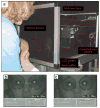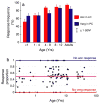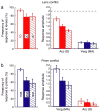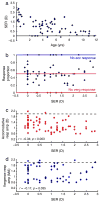Accommodative and vergence responses to conflicting blur and disparity stimuli during development
- PMID: 20053067
- PMCID: PMC3971876
- DOI: 10.1167/9.11.4
Accommodative and vergence responses to conflicting blur and disparity stimuli during development
Abstract
Accommodative and vergence responses of the typically developing visual system are generated using a combination of cues, including retinal blur and disparity. The developmental importance of blur and disparity cues in generating these motor responses was assessed by placing the two cues in conflict with each other. Cue-conflicts were induced by placing either -2 D lenses or 2 MA base-out prisms before both eyes of 140 subjects (2.0 months to 40.8 years) while they watched a cartoon movie binocularly at 80 cm. The frequency and amplitude of accommodation to lenses and vergence to prisms increased with age (both p < 0.001), with the vergence response (mean +/- 1 SEM = 1.38 +/- 0.05 MA) being slightly larger than the accommodative response (1.18 +/- 0.04 D) at all ages (p = 0.007). The amplitude of these responses decreased with an increase in conflict stimuli (1 to 3 D or MA) (both p < 0.01). The coupled vergence response to -2 D lenses (0.31 +/- 0.06 MA) and coupled accommodative response to 2 MA base-out prisms (0.21 +/- 0.02 D) were significantly smaller than (both p < 0.001) and poorly correlated with the open-loop vergence (r = 0.12; p = 0.44) and open-loop accommodation (r = -0.08; p = 0.69), respectively. The typically developing visual system compensates for transiently induced conflicts between blur and disparity stimuli, without exhibiting a strong preference for either cue. The accuracy of this compensation decreases with an increase in amplitude of cue-conflict.
Figures








References
-
- Alvarez TL, Semmlow JL, Pedrono C. Divergence eye movements are dependent on initial stimulus position. Vision Research. 2005;45:1847–1855. - PubMed
-
- Anker S, Atkinson J, Braddick O, Ehrlich D, Hartley T, Nardini M, et al. Identification of infants with significant refractive error and strabismus in a population screening program using noncycloplegic videorefraction and orthoptic examination. Investigative Ophthalmology & Visual Science. 2003;44:497–504. - PubMed
-
- Aslin RN, Dobson V. Dark vergence and dark accommodation in human infants. Vision Research. 1983;23:1671–1678. - PubMed
-
- Aslin RN, Jackson RW. Accommodative-convergence in young infants: Development of a synergistic sensory-motor system. Canadian Journal of Psychology. 1979;330:222–231. - PubMed
-
- Banks MS. Infant refraction and accommodation. International Ophthalmology Clinics. 1980;20:205–232. - PubMed
Publication types
MeSH terms
Grants and funding
LinkOut - more resources
Full Text Sources

